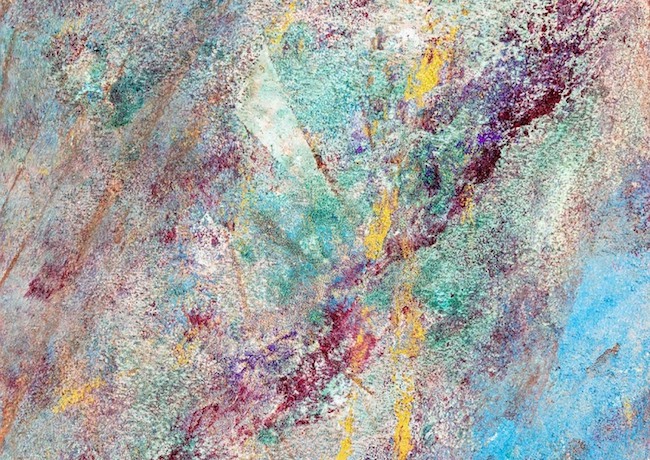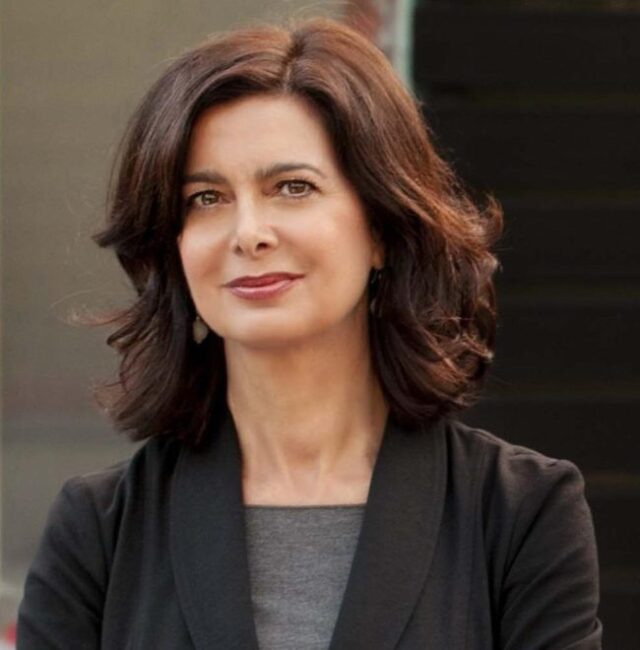Il concetto moderno di arte ha superato la staticità della tela per inoltrarsi in un campo sinergico dove tutto il corpo può essere coinvolgo nell’atto plastico del dare alla luce una nuova opera sulla quale liberare in maniera a volte concitata altre soffusa e sussurrata, tutte le emozioni che vengono ricevute dall’interiorità in maniera costante ma che spesso non riescono a trovare quella valvola di sfogo necessaria a dare un senso al groviglio percepito che spinge per giungere alla coscienza. In questo nuovo approccio alla pittura ciascun artista svela la propria inclinazione caratteriale ed emozionale, ponendosi in contatto con l’osservatore in maniera empatica, cercando di scuotere le sue corde emotive e trovando punto di incontro tra sensibilità differenti. La protagonista di oggi rende il fruitore partecipe della sua esperienza espressiva coinvolgendolo nel processo creativo che si pone in interrelazione con altre forme artistiche non figurative, fino alla scelta del titolo che nasce solo dopo il contatto con uno sguardo esterno.
Quando intorno alla fine dell’Ottocento alcuni artisti cominciarono ad avvertire la necessità di uscire dagli studi dove si dedicavano alla realizzazione delle loro opere e a trovare un modo per riuscire a dipingere in maniera più rapida perché funzionale a quel desiderio di stare all’aria aperta e cogliere ogni minimo dettaglio della realtà osservata, così come ogni minimo cambiamento di luce, ogni sfaccettatura della natura davanti a sé, si generò una vera e propria rivoluzione stilistica, nonché l’inizio di un modo differente di considerare il rapporto con la tela. La pittura en plein air contraddistinse uno dei movimenti più rivoluzionari da cui poi si generarono tutti i successivi studi sulla scomposizione dell’immagine e sull’azione esecutiva dell’artista che diedero vita nel Novecento alle avanguardie che segnarono il totale distacco con tutti gli schemi, le regole accademiche che fino a qualche decennio prima sembravano irrinunciabili. Quel movimento di fine Ottocento prese il nome di Impressionismo e fu caratterizzato da un’interazione con la tela completamente inedita poiché il gesto, la velocità di realizzazione includevano un movimento differente, un’elaborazione rapida, immediata proprio per non perdere quell’attimo irripetibile in cui la natura era in sintonia perfetta con l’intenzione rappresentativa dell’autore dell’opera. Nel proseguire del Ventesimo secolo l’importanza del gesto plastico divenne via via più rilevante al punto di costituire la base di una corrente artistica come lo Spazialismo dove l’atto di tagliare la tela era parte integrante della creazione e andava a cercare una nuova dimensione in cui subentrava anche il tempo inteso come azione creativa o la musica da interpretare attraverso i segni pittorici, come nelle opere di Ennio Finzi. Ma fu soprattutto l’Astrattismo di Vassily Kandinsky a gettare le basi per un legame forte e indissolubile proprio tra emozione e ascolto, tra colori e musica, tra mancanza di figurazione e intuizione legata al mondo del percepito; la sua ricerca fu ripresa e ampliata da Jackson Pollock che con la sua Action Painting trasformò la realizzazione di un dipinto in una vera e propria esperienza sensoriale in cui il corpo si muoveva concitatamente a ritmo di musica jazz attorno alla tela e il colore veniva letteralmente lanciato in maniera impulsiva lasciando al risultato finale il compito di narrare l’emozione provata nel momento creativo. Quynh Klaus, artista di origini vietnamite, nata e cresciuta in Ucraina ma da molti anni residente in Germania, riprende il concetto dell’importanza dell’esperienza immersiva per dar corpo a quel groviglio di emozioni che si depositano sulla sua interiorità, e in quella dell’essere umano, stratificandosi proprio perché incapaci di trovare un canale comunicativo con il quale indurre chi le prova a portarle in superficie, prenderne consapevolezza e poi liberarle.
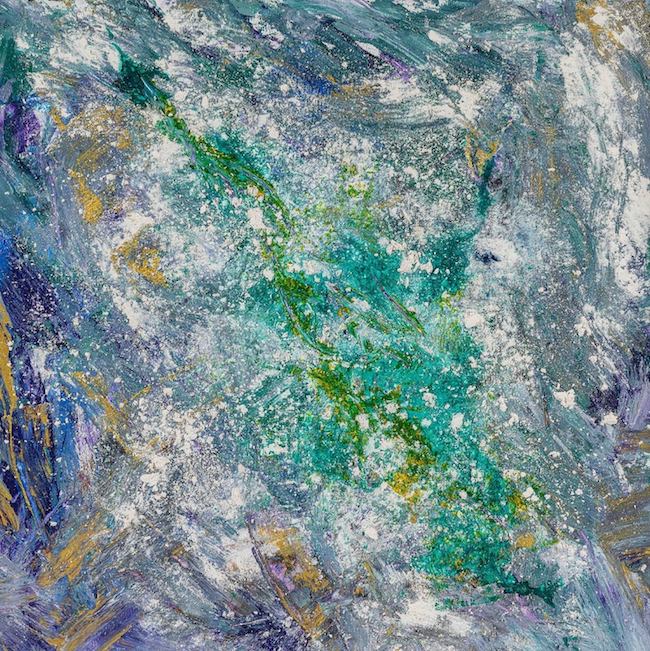
L’interazione tra corpo e tela, intesa come mezzo per manifestare il sentire, è per lei fondamentale soprattutto perché legato alla sinergia con la musica che ritiene essere una dimensione ideale in cui l’inconscio non si sente inibito bensì cullato e avvolto da note che si pongono in accordo melodico con quelle vibrazioni profonde legate al sentire. In questo modo Quynh Klaus si sente perfettamente in contatto con la sua interiorità, con quel momento presente che le consente di trasformare ogni opera in un’esperienza liberatoria che però cerca costantemente il contatto con l’osservatore, come se in qualche modo quell’esecuzione simile a un ballo, perché influenzata dalle note musicali ascoltate, volesse indurre gli altri a entrare nel suo momento emotivo, a coinvolgersi e divenire essi stessi parte del processo di creazione.
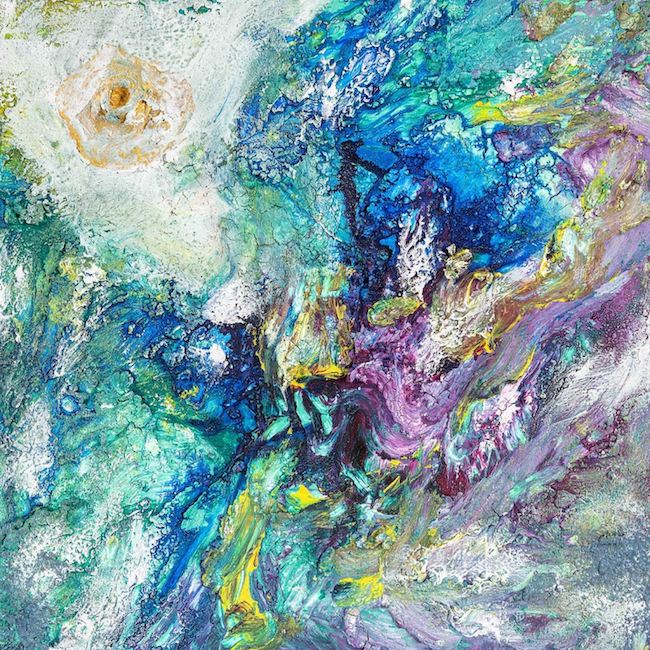
Il progetto Artescienza da lei creato punta proprio alla partecipazione di un pubblico esterno al suo processo inconscio di generazione di una tela, di quell’imprimere emozioni allo stato puro, senza alcun filtro razionale, che l’osservatore riceve e da cui si sente coinvolto in maniera altrettanto istintiva; il titolo dell’opera viene dato da Quynh Klaus solo dopo aver percepito e ascoltato le reazioni da parte degli osservanti, dando così vita a una cooperazione in cui il ricevente diviene protagonista e parte di un processo che trova il suo compimento proprio nel momento finale della denominazione. Irrinunciabile è il legame con la musica poiché è attraverso le note ascoltate che l’artista sceglie i colori determinando così la narrazione delle tele che ne svelano il carattere solare e dinamico proprio in virtù della luminosità, della vivacità cromatica, dell’impulso positivo che emerge travolgente dalle sue opere assolutamente riconducibili all’Espressionismo Astratto.
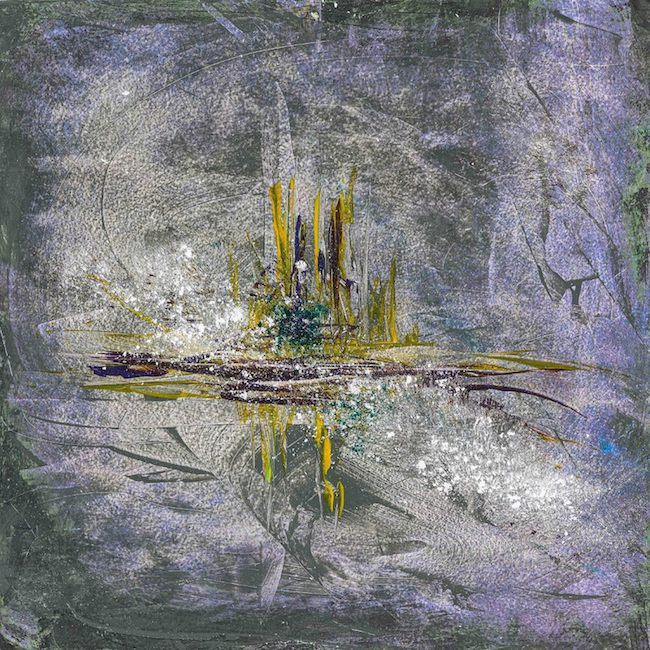
Nella tela Cosmic Castle in a Diamond Milky Way (Castello Cosmico in una Diamantata Via Lattea) le tonalità sono polverose, certo, eppure lievi, delicate, lontane dal buio che l’immaginario comune riconduce al cosmo, allo spazio infinito; l’immagine appena sussurrata è quella di una struttura ipermoderna al punto da essere irreale ma in fondo un posto verso cui tendere in virtù della presenza di quel glitter, di quella polvere di stelle appartenente alla Via Lattea evocata nel titolo, che ne illumina lo spazio circostante e che sembra indurre l’osservatore a sentirsene protetto.
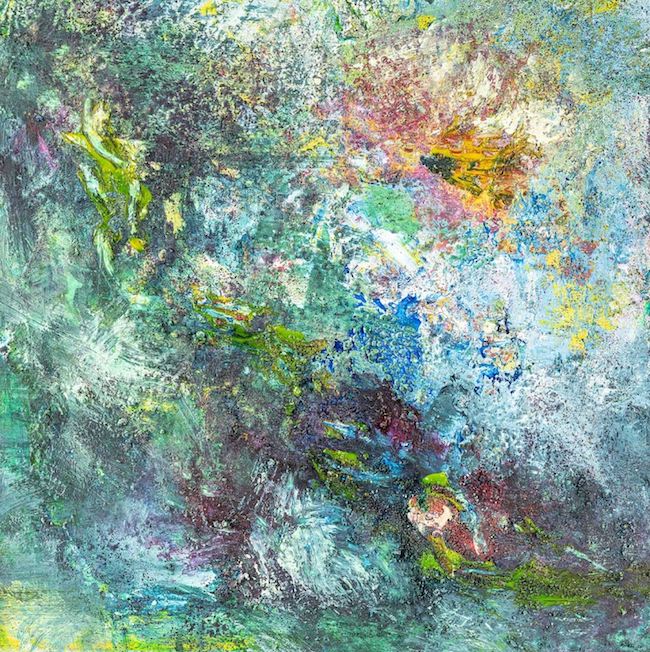
E ancora in Colorful Chaos (Caos Colorato) l’energia dei colori si associa per formare un inaspettato connubio, un approccio diverso al disordine che spesso viene considerato negativamente poiché associato alla mancanza di stabilità e di certezze; in questa tela invece lo sguardo è divertito, indulgente verso gli accadimenti che sopraggiungono destabilizzanti, proprio perché l’artista conosce bene il valore dell’elasticità, della resilienza di adeguarsi a ciò che si verifica e, a volte, lasciarsi cambiare da quegli eventi improvvisi che hanno sempre una loro ragion d’essere.
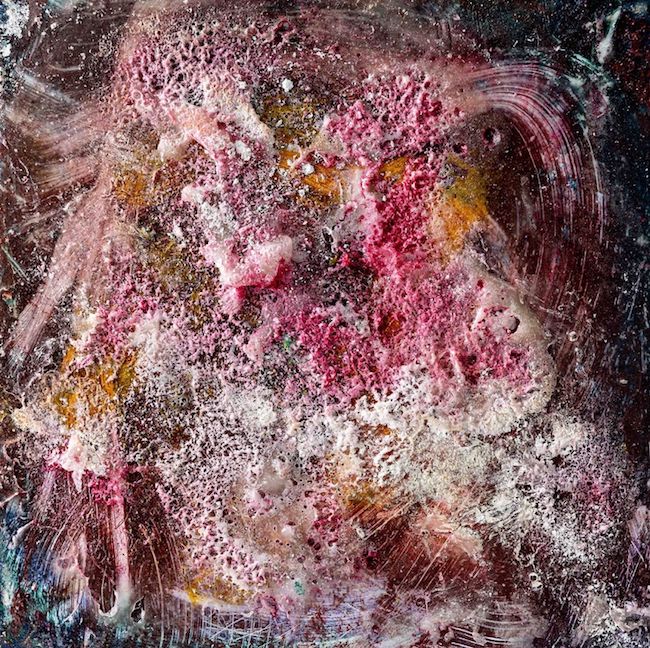
In Pink Splash (Tuffo Rosa) ancora una volta Quynh Klaus mostra il suo punto di vista positivo verso l’esistenza, quel vedere la vie en rose della canzone della Piaf attraverso cui tutto può cambiare, ogni circostanza può avere un risvolto evolutivo e costruttivo, se ne sanno vedere le potenzialità piuttosto che fermarsi al momento specifico che può anche apparire solo spiacevole o fastidioso. Osservando invece le cose con un approccio aperto, possibilista e soprattutto sereno, si può intuire le opportunità che scaturiscono da una deviazione di percorso, da un esplosivo cambiamento che potrà condurre verso una maggiore realizzazione e felicità.
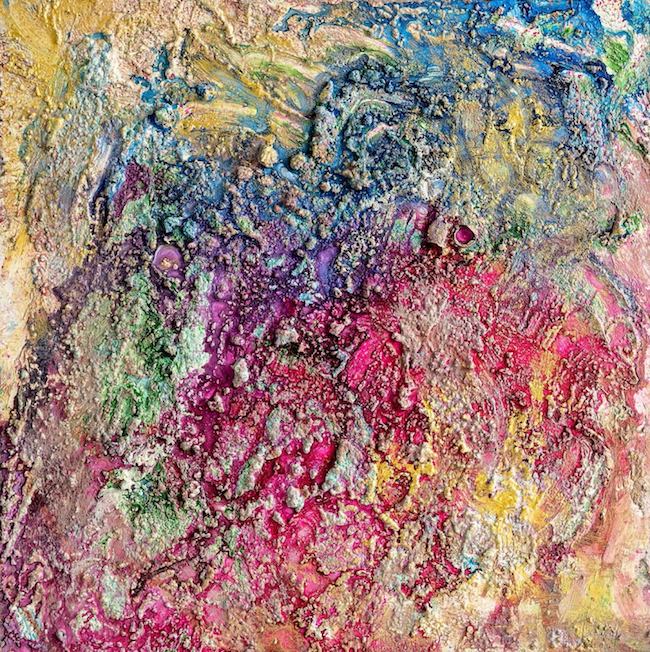
Figlia di un ricercatore e professore di matematica e di una ballerina dell’Accademia di Danza del Vietnam di Hanoi, Quynh Klaus non poteva non ereditare entrambe le nature dei suoi genitori che la spingono costantemente a trovare un equilibrio tra razionalità e impulso, tra morbidezza della musica e del ballo e la ricerca mentale con cui crea e trova modi per coinvolgere il pubblico a lasciarsi andare al meraviglioso mondo delle sensazioni, delle emozioni destabilizzanti, certo, ma le uniche a permettere all’interiorità di arricchirsi e autoalimentarsi costantemente. Laureata in Fisica, specializzata in Radiologia ma anche diplomata come stilista, inizia a dipingere nel 2020 quasi come se alla sua poliedrica formazione scolastica e professionale mancasse un tassello, quello in cui potesse esprimersi liberamente sulla tela, che in realtà è una superficie acrilica su cui la sua struttura liscia entra in contrasto con il rilievo strutturale dell’opera; Quynh Klaus ha al suo attivo la partecipazione a diverse mostre collettive in Germania e all’estero.
QUYNH KLAUS-CONTATTI
Email: info@quynhklaus.com
Sito web: https://www.quynhklaus.de/
https://qk.gallery/en
https://www.ochgallery.de/
Facebook: https://www.facebook.com/profile.php?id=100070408254297
Instagram: https://www.instagram.com/quynhklaus/
A whirlwind of emotions and total immersion in the creation of the artwork with Quynh Klaus’ Abstract Expressionism
The modern concept of art has overcome the static nature of the canvas to enter a synergistic field where the whole body can be involved in the plastic act of giving birth to a new work of art on which to release, sometimes in an excited manner and sometimes in a suffused and whispered one, all the emotions that are constantly received from the interior but which often fail to find the necessary release valve to make sense of the perceived tangle that pushes to reach consciousness. In this new approach to painting, each artist reveals his own character and emotional inclination, coming into contact with the observer in an empathetic manner, seeking to shake his emotional chords and finding a meeting point between different sensibilities. Today’s protagonist makes the viewer a participant in her expressive experience, involving him in the creative process that interrelates with other non-figurative artistic forms, up to the choice of the title, which only comes about after contact with an external gaze.
When around the end of the nineteenth century some artists began to feel the need to leave the studios where they were making their artworks and to find a way of painting more quickly because it was in keeping with their desire to be in the open air and to capture every detail of the reality they observed, as well as every change in the light, every facet of nature in front of them, a true stylistic revolution was generated, as well as the beginning of a different way of considering the relationship with the canvas. Painting en plein air distinguished of the most revolutionary movements that generated all the subsequent studies on the decomposition of the image and on the artist’s executive action that gave rise to the avant-garde movements of the 20th century, marking a total break with all the schemes and academic rules that had seemed inalienable until a few decades earlier. This movement of the late 19th century took the name of Impressionism and was characterised by a completely unprecedented interaction with the canvas, since the gesture and the speed of its realisation included a different movement, a rapid, immediate elaboration precisely so as not to lose that unrepeatable moment in which nature was in perfect harmony with the representative intention of the author of the artwork. As the twentieth century progressed, the importance of the plastic gesture became increasingly important, to the point of forming the basis of an artistic movement such as Spatialism, where the act of cutting the canvas was an integral part of creation and went in search of a new dimension in which time also took its place, understood as a creative action or music to be interpreted through pictorial signs, as in the works of Ennio Finzi.
But it was above all the Abstractionism of Vassily Kandinsky that laid the foundations for a strong and indissoluble bond between emotion and listening, between colours and music, between lack of figuration and intuition linked to the world of perception; his research was taken up and expanded by Jackson Pollock, who with his Action Painting transformed the creation of a painting into a true sensory experience in which the body moved concisely to the rhythm of jazz music around the canvas and the colour was literally thrown in an impulsive manner, leaving the final result with the task of narrating the emotion felt in the creative moment. Quynh Klaus, an artist of Vietnamese origin, born and raised in the Ukraine but who has lived in Germany for many years, takes up the concept of the importance of the immersive experience to give substance to that tangle of emotions that are deposited in her interiority, and in that of the human being, stratifying precisely because they are unable to find a communicative channel through which to induce those who experience to bring them to the surface, become aware and then release them. The interaction between body and canvas, interpreted as a means of manifesting feeling, is fundamental for her especially because it is linked to the synergy with music, thant she considers to be an ideal dimension in which the unconscious does not feel inhibited but cradled and enveloped by notes that are in melodic accord with those deep vibrations linked to feeling. In this way, Quynh Klaus feels perfectly in touch with her inner self, with that present moment that allows her to transform each artwork into a liberating experience that, however, constantly seeks contact with the observer, as if in some way that dance-like performance, because it is influenced by the musical notes she hears, wants to induce others to enter into her emotional moment, to get involved and become part of the creation process themselves.
The Artscience project she has created focuses precisely on the participation of an external audience in her unconscious process of generating a canvas, of imprinting emotions in a pure state, without any rational filter, which the observer receives and feels involved in an equally instinctive way; the title of the artwork is given by Quynh Klaus only after perceiving and listening to the reactions of the observers, thus giving rise to a cooperation in which the receiver becomes the protagonist and part of a process that finds its completion in the very final moment of naming. The link with music cannot be renounced, since it is through the notes listened to that the artist chooses the colours, thus determining the narration of the canvases, which reveal their solar and dynamic character precisely by virtue of the luminosity, chromatic vivacity and positive impulse that emerge overwhelmingly from her works, which can be traced back to Abstract Expressionism. In the canvas Cosmic Castle in a Diamond Milky Way, the tones are dusty, certainly, but light, delicate, far from the darkness that the common imagination leads us back to the cosmos, to infinite space; the barely whispered image is that of a hyper-modern structure to the point of being unreal, but in the end a place towards which to strive by virtue of the presence of that glitter, that stardust belonging to the Milky Way evoked in the title, which illuminates the surrounding space and seems to induce the observer to feel protected by it. And again in Colorful Chaos the energy of the colours is combined to form an unexpected union, a different approach to disorder, which is often considered negatively because it is associated with a lack of stability and certainty; in this canvas, however, the gaze is amused, indulgent towards the destabilising events that occur, precisely because the artist is well aware of the value of elasticity, of the resilience to adapt to what is happening and, at times, to allow oneself to be changed by those sudden events that always have their own reason for being.
In Pink Splash, Quynh Klaus once again shows her positive point of view on existence, that view of la vie en rose from Piaf’s song through which everything can change, every circumstance can have an evolutionary and constructive implication, if you can see the potential rather than stopping at the specific moment that may even appear only unpleasant or annoying. Instead, by observing things with an open, possibilist and above all serene approach, one can perceive the opportunities that arise from a deviation in the path, from an explosive change that can lead to greater fulfilment and happiness. Daughter of a researcher and professor of mathematics and a dancer from the Vietnam Dance Academy in Hanoi, Quynh Klaus could not help but inherit both natures from her parents, who constantly push her to find a balance between rationality and impulse, between the softness of music and dance and the mental research with which she creates and finds ways to involve the public in letting themselves go to the wonderful world of sensations, destabilising emotions, of course, but the only ones that allow interiority to enrich itself and constantly feed itself. Graduated in Physician, specialised in Radiology but also graduated as a stylist, she started painting in 2020 almost as if her multifaceted scholastic and professional training was missing a piece, the one where she could freely express herself on the canvas, which is actually an acrylic surface on which the smooth structure contrasts with the structural relief of the artwork; Quynh Klaus has to her credit the participation in several group exhibitions in Germany and abroad.


